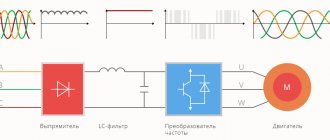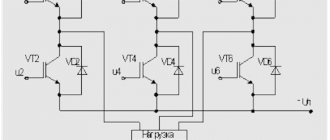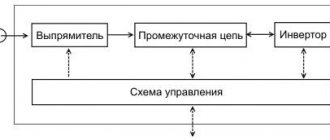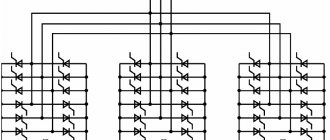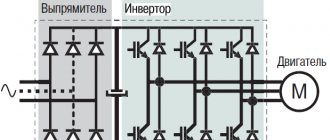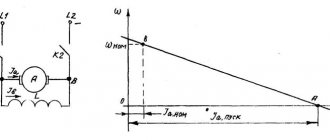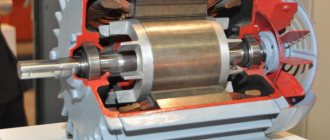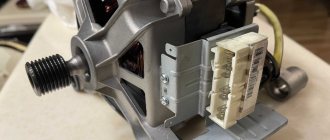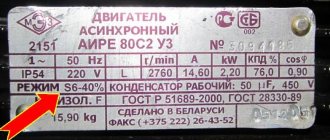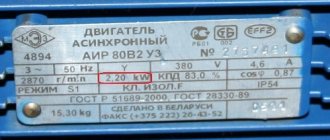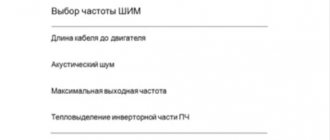The power and electric current of the frequency converter, the voltage when two motors are connected to it at the same time, is selected in excess of 20% of the total power of the electric motors. To calculate the length of the electrical cable, you need to add up the dimensions of all the cables of the two motors. It is necessary to reduce the overall length if you connect two electric motors specifically to the contacts of the frequency converter. With two electric motors, it is advisable to install a motor choke, despite the fact that the total length of these cables is not more than the longest length.
Many frequency converters do not tolerate connecting and disconnecting current electric motors with contactors with an electric drive during operation, but only by turning on the STOP command on the drive.
Data collected when visiting the site
Personal Information
Personal data when visiting the site is transferred by the user voluntarily, this may include: first name, last name, patronymic, telephone numbers, email addresses, addresses for delivery of goods or provision of services, details of the company that the user represents, position in the company that the user represents, social media accounts; form fields may also request other data.
This data is collected for the purposes of providing services or selling goods, communicating with the user or other user activity on the site, and to send users information that they have agreed to receive.
We do not check the accuracy of the data provided, but we do not guarantee high-quality execution of orders or feedback from us if the data is incorrect.
The data is collected using forms available on the site for filling out (for example, registration, placing an order, subscribing, leaving a review, feedback, and others).
Forms installed on the site can transmit data both directly to the site and to third-party sites (scripts for third-party services).
Data may also be collected through cookie technology, both directly by the site and by scripts from third-party services. This data is collected automatically; the sending of this data can be prevented by disabling cookies in the browser in which the site is opened.
Non-personal data
In addition to personal data, when visiting the site, non-personal data is collected; it is collected automatically by the web server on which the site is located, CMS (content management system) tools, and third-party scripts installed on the site. Data collected automatically includes: IP address and country of registration, the name of the domain from which you came to us, visitors’ transitions from one page of the site to another, information that your browser provides voluntarily when visiting the site, cookies, visits and other data collected by third-party analytics counters installed on the site are recorded.
This data is non-personal in nature and is aimed at improving customer service, improving the usability of the site, and analyzing traffic.
Is it possible to have two identical motors for one frequency drive?
Theoretically, such a connection is not recommended, especially for a vector frequency converter. It can be connected to a scalar motor if the electric motors operate together on the same shaft, and they can be phased smoothly through a slip current clutch. It is possible to adjust the arrangement of the rotors between each other using a coupling. Then the coupling must be secured. At a small load, adjust the currents between the motors using current clamps.
There are certain current and voltage converters that allow the operation of two electric motors simultaneously under a joint load. Although, both motors have their own frequency generator and an additional control line between the converters.
It is problematic to connect two equal electric motors. You can connect one by one without problems, even with different parameters. The connection is made through package-type starters and switches.
Micromaster can control two electric motors at once. The parameter values must be created correctly, and heat protection must be set separately.
You can install two motors on one frequency converter, but on two different shafts. In the frequency generator, extend one contact at a time from the corresponding electric motor.
Let's give an example. We have two 0.5 kW motors. We want them to be operated together at one load of 0.8 kW per frequency converter. It is impractical to purchase two converters at once; they operate synchronously, and it is inconvenient to adjust two frequency converters.
Connecting both electric motors with one frequency converter at once entails some nuances. The main difficulty is the protection of the engines. It is difficult to find a fault problem with one of the motors when connected in parallel. For example, two factory motors operate on one converter. Three cutters were working. One cutter failed and became dull. Because of this, the frequency converter began to heat up. It is necessary to install thermal relays with converter protection for maximum current and voltage on all motors. Otherwise, the current frequency protection relay cannot recognize the fault. It is bad if there is a switch at the output of the converter. If the motor breaks during operation, the frequency converter will fail.
Thermal protection is of great importance, but it is possible to do without it. It is allowed to be on a vector without feedback; a complete vector is difficult to obtain. Through experimentation, possibilities will emerge. On a working converter at the output, everything functions without difficulties. If you do not overload frequency converters with capacitors, they will last a long time.
Hyundai converters are well suited for two electric motors. They have their own protection against heating (thermal relays), which is necessary for each motor. This is determined by several facts:
- The load is unevenly distributed. Electric current of different magnitude on both motors.
- Possibility of switching off one motor. The protection for the 0.8 kW motor, built into the frequency converter, will not work.
It is recommended to place an equal load on the frequency generator from both engines. This refers to the load during operation. A break during no-load operation is normally tolerated by the current converter. When the supply voltage was suddenly cut off, the starting switch, which switches the electric motor, turned off more often than the frequency switch turned off.
Providing data to third parties
We do not disclose users' personal information to companies, organizations or individuals not affiliated with us. The exceptions are the cases listed below.
User data is publicly available
The user’s personal data may be published publicly in accordance with the functionality of the site, for example, when leaving reviews, the name specified by the user may be published; such activity on the site is voluntary, and the user, by his actions, consents to such publication.
As required by law
Information may be disclosed to prevent fraud or other illegal activities; as required by law and in other cases provided for by law.
To provide services and fulfill obligations
The user agrees that personal information may be transferred to third parties in order to provide services ordered on the site and fulfill other obligations to the user. Such persons, for example, include courier services, postal services, cargo transportation services and others.
Third party services installed on the site
The site may contain forms that collect personal information from other organizations; in this case, the collection, storage and protection of the user’s personal information is carried out by third parties in accordance with their privacy policy.
The collection, storage and protection of information received from a third party is carried out in accordance with this privacy policy.
Connecting two motors to one frequency converter
When designing and modernizing an electric drive with frequency converters, it is often necessary to solve the problem of connecting 2 or more motors to one frequency converter.
Such circuits are used in ventilation systems, cascade water supply installations, drives of machine tools and other equipment. There are several options for conditions:
- It is required to connect 2 identical electric motors connected in parallel.
- It is necessary to implement alternate operation of several different engines operating in different parts of the technological chain with different loads.
- Requires connection of 2 motors that differ in power.
Changes to the privacy policy
We have the discretion to update this privacy policy at any time. In this case, we will post a notice on the home page of our site. We encourage users to frequently check this page to stay informed of any changes to how we protect the user information we collect. By using the site, you agree to accept responsibility for periodically reviewing the privacy policy and changes to it.
Alternate connection of electric motors
When using a non-specialized frequency converter to alternately control several drives, you must:
- Provide a switching lock when the electric motor is running. All switching must be done when the frequency generator is switched to the “Stop” mode.
- Implement a protective shutdown of the inverter before disconnecting contactors or switches in the event of a voltage loss in the output circuit.
Danfoss produces several series of special frequency converters for controlling several electric motors. All functions necessary for this are implemented in the software and hardware of the inverter. The operation of each drive can be programmed in the settings. The inverter has built-in thermal relays and corresponding inputs and outputs.
The use of such devices eliminates the need for phasing motors, calculating the characteristics of the frequency converter, the need to install additional switching and protective devices, and also guarantees correct operation of the drives in all intended modes.
Source
Connecting two motors to one frequency converter
The power and electric current of the frequency converter, the voltage when two motors are connected to it at the same time, is selected in excess of 20% of the total power of the electric motors. To calculate the length of the electrical cable, you need to add up the dimensions of all the cables of the two motors. It is necessary to reduce the overall length if you connect two electric motors specifically to the contacts of the frequency converter. With two electric motors, it is advisable to install a motor choke, despite the fact that the total length of these cables is not more than the longest length.
Many frequency converters do not tolerate connecting and disconnecting current electric motors with contactors with an electric drive during operation, but only by turning on the STOP command on the drive.
Selection of frequency converter
2.1 Frequency converter for single-phase motor
It is worth noting that standard frequency converters are not designed to work with single-phase motors. Almost all frequency converters on the market are designed to control the rotation speed of a three-phase squirrel-cage induction motor.
More often, when they say “single-phase frequency converter,” they mean a frequency converter powered by a single-phase 220V network. Such a converter has 3 phases of 220V at the output and is also designed to control a three-phase asynchronous motor.
However, frequency converters for single-phase motors exist, but are extremely rare.
Figure 1 - Inverter for a three-phase motor
2.2 Selection of frequency converter by power
When selecting a converter, you first need to focus on the current and supply voltage of the electric motor. This information is indicated on the engine nameplate.
Figure 2 - Engine nameplate
1. Voltage on the windings. The motor, the nameplate of which is shown in Figure 2, is capable of operating at a three-phase voltage of 220V (the windings must be connected in a delta circuit)
) and at a three-phase voltage of 380V (
star
). If the nameplate indicates 380/660, then such a motor can be connected to an inverter with a 220V power supply, but in this case the rated characteristics of the motor will not be ensured.
2. Rated linear current of the motor. This motor consumes 1.44A when connected in a delta (220V power supply) and 0.83A when connected in a star (380V power supply).
The rest of the information given on the motor nameplate does not affect the choice of inverter.
Despite the current indicated on the motor nameplate, the most correct method for determining the operating current is to directly measure it while the motor is running. This will avoid problems if the motor operates at high current. The actual continuous operating current of the motor should not exceed the rated output current of the inverter.
What is a frequency converter and in what cases is it used?
The frequency converter is designed to control the rotation speed of a three-phase asynchronous electric motor with a squirrel-cage rotor.
Appearance of frequency converters
Frequency converters are used in the following cases:
- if necessary, change the rotation speed of the electric motor;
- if it is necessary to maintain the value of a process parameter (for example, pressure) by changing the rotation speed of the electric motor;
- no 380V power supply. Frequency converters with 220V power supply are supplied with power up to 2.2 kW inclusive. The engine power is not lost in this case (If the engine has the ability to switch “ star-delta
” 380/220, then it can be turned on from a single-phase 220V network); - connection to an industrial network of motors with a “non-standard” supply voltage and frequency is required.
In addition to the main functions, the inverter provides
- the ability to turn on reverse without additional equipment;
- motor starting current limitation;
- motor current control;
- smooth acceleration and braking (time adjustable);
- additional engine protection;
- possibility of skipping resonant frequencies;
- stabilization of motor torque even with fluctuations in input voltage;
- possibility of stopping with deceleration;
- the ability to save energy with a partially loaded engine (even without a feedback sensor);
- work with built-in timer and counter;
- transition to “sleep mode” with the pump turned off in the absence of water consumption;
- Possibility of automatic restart when power is restored.
All listed parameters (functionality) are supported by ELHART frequency converters of the EMD-MINI and EMD-PUMP series.
Motor speed control range when using a frequency converter
3.1 Using an inverter to reduce motor speed
To operate at low frequencies (below 10-15 Hz), special attention must be paid to motor cooling and shaft torque.
Enclosed fan cooled motor ( TEFC)
) has cooling only due to the built-in fan. The performance of the cooling fan decreases in proportion to the engine speed. When engine speed is reduced, cooling efficiency decreases, which leads to engine overheating and possible failure.
There are several options for cooling the electric motor when operating at low frequencies:
- reduce the period of continuous operation of the engine at low frequency
- organize additional cooling;
- reduce the load on the motor shaft;
- install a reduction gearbox, which will increase engine speed;
- use a larger motor.
The volt-frequency control method allows you to maintain a constant torque on the motor shaft at different speeds. When operating at low frequencies (below 5-10 Hz), the torque on the shaft will depend on the characteristics of the specific motor (active resistance of the windings). To maintain torque at frequencies below 5-10 Hz, it may be necessary to adjust the minimum voltage of the U/f
. Increasing the voltage value will cause an increase in starting torque, but will also lead to an increase in current consumption, and in proportion to the increase in flowing current, heating increases. Recommended frequency control range for voltage-frequency control: 5-50 Hz. The ELHART EMD-MINI frequency converter supports frequency adjustment from 0.5 to 999.9 Hz.
The vector control method is able to more accurately maintain torque at low frequencies (especially with changing loads). The range of possible adjustment is wider than that of the volt-frequency mode and depends on the specific model (company, series) of the inverter. For vector control, it is recommended to use Delta Electronics frequency converters of the VFD-E and VFD-C series.
To increase the starting torque, it is recommended to use a frequency converter of higher power (since the converter can only provide the motor with one and a half times the current (rated current × overload capacity of the inverter).
Lenze smd parallel connection of two electric motors
If you connect two electric motors in parallel to the ESMD402L4TXA 4 frequency converter, it is recommended to install thermal relays to protect against current overloads. To control the temperature, it is necessary to install temperature sensors.
Information from engineers: is it possible to connect two motors simultaneously to the frequency converter?
1) It is recommended to use thermal relays of frequency converter types TRP, RTT, TRN. The contacts that open these relays are connected in series to the discrete input of the ESMD frequency converter. The discrete input is programmed with a shutdown function due to external failure. The parameter has a value of 10.
2) It is allowed to connect thermal relays to such frequency generators. They will open the contact at high temperatures. When connecting two sensors, the contacts are connected in series. Thermistors, thermocouples, and temperature sensors are not recommended for use.
Most often, when connecting two electric motors to one frequency converter, RTL thermal relays are used, equipped with a KRL adapter, so that you can install them yourself. The permanently closed contacts of the RTL thermal relay are included in the Lenze frequency switch circuit. The permanently open contact was connected to the signal lamp during an electric motor failure.
To be able to connect two electric motors in parallel, the following laws must be observed:
- frequency - voltage, quadratic law;
- frequency – voltage law with IR compensation in automatic mode.
The electric current of the frequency generator must be no less than the sum of the currents of both electric motors. To do this, use external thermal protection for both engines using thermal relays or thermistors. It is better to install an output filter with a function to cut off excess voltage between the motors and the frequency converter.
The two most applicable options are:
- Motors with the same power. After adjusting the frequency converter, the torque characteristic does not change.
- Electric motors with unequal power. Torque data is not optimal for engines.
Source
